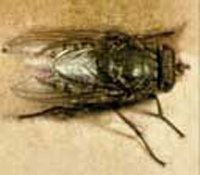|  Cluster
Flies Cluster
Flies
Order: Diptera
Family: Calliphoridae
Scientific Name: Pollenia rudis
Color: Non-metallic, light and dark gray areas
on abdomen
Legs: Six
Shape: Small oval
Size: About 5/16 inch long
Antennae: Yes
Flight: Yes
The cluster fly is slightly larger than the common house fly. There
are no distinct lines or stripes behind the head, and the abdomen
has irregular light and dark gray areas. These insects, sometimes
called "attic flies", often become pests in homes. They
usually appear in late fall or early winter and again on warm, sunny
days in early spring. They buzz around the home and gather in large
numbers at windows, often in rooms that are not regularly used.
The cluster fly is a little larger than the common housefly and
moves sluggishly. It can be recognized by the short, golden colored
hairs on its thorax, the part of the body to which the legs and
wings are attached. The larvae, or maggots, of cluster flies develop
as parasites in the bodies of earthworms.
Habits
The female lays eggs in the soil near the burrows of earthworms.
The tiny maggots that hatch from the eggs seek out earthworms to
feed upon. The maggots of cluster flies have never been reared on
any other food but living earthworms. When full grown, the parasitic
maggot leaves the body of the host and enters the soil. There are
about four generations a year.
Habitat
Adult flies of the last generation of the year become numerous during
the latter days of September to mid-October. As cold weather progresses,
adults seek protected places to spend the winter. In many cases,
this is within walls, attics, storage rooms, and basements of houses.
Screens offer no protection since these flies prefer to crawl in
through small openings elsewhere around the building. For this reason
they are extremely difficult to keep out of houses. Isolated houses
in the country are especially prone to invasion, since they offer
the only warm shelter for miles around.
Threats
Cluster flies are parasitic on certain earthworms. They are only
a nuisance to humans.
Control
Complete control of cluster flies is almost impossible since the
overwintering adults are concealed in walls, attics, etc. When possible,
cover the louver to the attic with screen, and use a caulking compound
to seal openings to the outside. Adults are sluggish enough in the
winter to be picked up with a vacuum cleaner. It is probably not
practical to attempt to control the host of cluster flies, earthworms,
in the ground around the house. Earthworms are important to soil
and cluster flies would simply come from surrounding areas. Chemical
control should be concentrated in the home where the adults hibernate.
When crushed, cluster flies leave a greasy spot on upholstery, carpets,
and wood surfaces.
(Source: National Pest Management Association, et. al.)
|